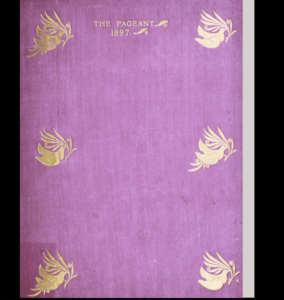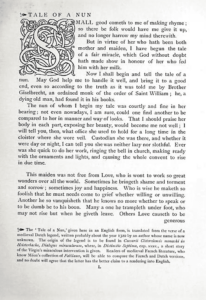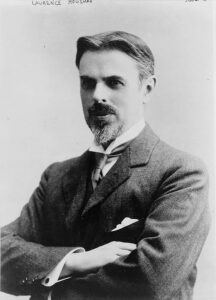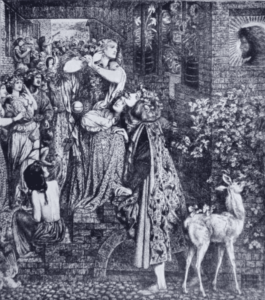Spirituality and Sexuality in Laurence Housman’s “The Tale of a Nun”
© Nikita Ruzycky, Ryerson University 2018
Introduction

The avant-garde magazine, The Pageant, is filled with prestigious literary, artistic and aesthetic contents that reflect the decadent culture at the fin-de-siècle. The literary editor was Gleeson White, and the art editor, Charles H. Shannon. Together, White and Shannon curated two volumes of The Pageant with the first issue running in December 1896 and the second in 1897. Volume one offers an untraditional context that is composed of medieval Florentine plays, Pre-Raphaelite influences, and stories like “The Tale of a Nun” that intertwines past and present motifs within the magazine.
Laurence Housman, the translator of “The Tale of a Nun” was a decadent scholar during the Victorian era who pushed the typical frameworks in artistic culture. “The Tale of a Nun” pertains to a nun, Beatrice, who escapes her convent with her lover and bears two children. Once Beatrice returns to the convent at the end of the story, rather than being treated as a sinner of God and shunned from the nunnery, she finds everything as it was and was welcomed back into God’s arms. The decadence of Housman’s work and of the Victorian era are reflected in this story as it questions the societal norms of sexuality and spirituality through Beatrices’ role as a women, wife and mother.
The medieval legend combines the sexual and the spiritual in Beatrice’s ambiguous character, highlighting the Pre-Raphaelite undertones of the magazine. It is evident that the Pre-Raphaelite notion around sexuality and spirituality does not oppose but is rather intertwined in “The Tale of a Nun”, which correlates to Housman’s inclusion of the story in The Pageant. Housman’s intrigue with decadence, medievalism and Pre-Raphaelitism are all reflected in the story and together symbolize his dissident identity. Thus, “The Tale of a Nun” challenges the typical views of women using the old medieval legend in The Pageant to critique the Victorian ideology of sexuality and spirituality as being sinful to society, cultural identity and God.
Folklore

Folklore is a record of manners and customs that are retold through different forms of media over several generations and often in different languages (Simpson and Roud). Folklore is essentially a survival of the past that is constantly developing to educate future societies. This view of folklore, as oral or written traditions that must be kept relevant through time is preserved by Housman’s revelation of the story in 1896. The original legend dates to the Medieval era and was spoken in Dutch until Housman’s translation into English for The Pageant.
The narrator discusses an old monk, Brother Giselbrecht, who told him “The Tale of a Nun” for the first time. The narrator resumes by stating “Now I will begin to tell the tale of a nun” which demonstrates the passing on of the story once again to a new generation. The tales’ integration in The Pageant exemplifies its long history of surviving the past through people like Brother Giselbrecht, the narrator and eventually Housman who introduced the story in the Victorian era. Not only has the legend been translated and presented verbally and written, which pertains to folkloric tradition, “The Tale of a Nun” has a greater meaning and impact as it personally connects to those who choose to retell it. Thus, the genre of folklore best represents “The Tale of a Nun” since the story is a survival of the Medieval and Victorian eras and continues to educate future generations by commemorating the past.
However, in addition to folkloric tales being solely survivals of the past, folklore is also a genre that challenges literary realism and causes readers to explore the different approaches of curators through time. By considering the political, religious and personal influences of past cultures the meaning and purpose of the stories relevance may change (Harris 5). Meaning that all folktales and legends like “The Tale of a Nun” delineate the borders of a single truth, causing readers to individually decipher the greater meaning of the story. For instance, to some “The Tale of a Nun” presents the role of a strong mother, wife, and virtuous servant of God, however to other critics like Housman, they may associate the tale with sexual and religious dissidence and as an erotic symbol of decadence. Thus, the process of interrogating folklore is essential in shaping the literary fantastic of “The Tale of a Nun”; the context of the story will never change, however its unfixed identity and interpretation will be manipulated through time to adjust to new traditions.
The Decadent and Pre-Raphaelite Movements
The Decadent and Pre-Raphaelite Movements are pivotal in understanding the cultural setting of the Victorian era, and the importance of “The Tale of a Nun’s” integration and purpose in The Pageant. Decadence is referred to as the decline of cultural standards that led to the reformation of society by introducing a new structure to mainstream traditions (Buchanan). Since “The Tale of a Nun” is an unusual story where a devoted nun escapes her convent for love and bears children, its untraditional religious and sexual framework reflects the decadence in the Victorian era. British decadent literature also experiments with redefining religion entirely and how authors incorporate their personal dissident views regarding literary gender, sexuality, and genre in their works (Benhardus). Housman for instance, attempts to portray a different form of religion through “The Tale of a Nun” by incorporating his personal views of decadence and Christianity into his works.
Pre-Raphaelite art pertained to curating works that questioned and challenged society. Pre-Raphaelitism is an artistic movement that claimed its own deviant expression of beauty and introduced its viewers and critics to a new language of radical art in the middle of the century (Casteras). For example, some artists portrayed the Virgin Mary and Christ with red hair which was considered unlucky and deemed an inappropriate representation of the Holy family (Cooper 22). The Pre-Raphaelite culture also curated works that borderline on the dissident representations of the spiritual and sexual. Pre-Raphaelite artists would typically portray women in constrained yet sensuous and promiscuous positions using medieval detailing, while still referencing religion in the illustration.
By curating works for a smaller scale medium like a magazine, the Pre-Raphaelites were able to tackle subjects that would be difficult to sell in their larger oil paintings (Cooper 64). Pre-Raphaelite artists were intrigued by the Middle Ages and merged this medieval culture of art and expression of beauty with those in the Victorian era through little magazines, like The Pageant. Together, the Decadent and Pre-Raphaelite Movements had a great influence on Victorian artists, illustrators and literary enthusiasts at the fin-de-siècle like Housman, as it introduced them to a new individualized form of artistic expression. Ultimately, both movements symbolize a period of reformation and experimentation, since the dissident views of culture, religion and beauty was shared between the medieval and Victorian era’s.
Christianity and Identity
While the art and literature fields developed in the 1890s, Christianity played a crucial role in influencing curators and how they chose to express their identity through art. Housman was known to struggle with his faith and expressed this uncertainty through his works to find his artistic voice and position in society.
The religious ideologies of Oscar Wilde and William Pater intrigued Housman as they studied the critical relationship between Christianity and moral identity. Together, Wilde and Pater believed that religion was constantly changing and in a state of flux (Knight 42). This methodology correlates to Beatrice’s role in “The Tale of a Nun”. Beatrice challenges herself and her relationship with God as she escapes the nunnery and bears children, yet she proves her virtuous morality when she returns and repents to the abbot. This change of perspective in Beatrice’s spirituality coincides with Wilde’s and Pater’s theory, suggesting that Housman also considered religion as being in a state of flux when he chose to retell “The Tale of a Nun”. Beatrice’s role in the story is very much about her relationship and devotion to God, which is suddenly betrayed when she escapes. However, Beatrice’s welcoming return, the abott retelling her story as a worshiped parable, and her children being raised as monks demonstrates how the Christianity in this story differs from traditional customs. Rather than being punished for her dissident behavior, Beatrice is forgiven by the abott, God, Mary and herself. Thus, Wilde’s and Pater’s views on religion greatly influenced Housman’s identity and expression of the sexual and spiritual in the 1890s. Housman expressed his religious uncertainties in the ambiguoussnes of Beatrice’s character to challenge the typical notions of Christianity and emphasize the fluctuation of religion at the fin-de-siècle.
Laurence Housman and Role in The Pageant

Housman was intrigued by many artistic practices until he began illustrating through detailed pen drawings after meeting with Charles Ricketts in 1890. William Blake, Charles Ricketts, Max Beerbohm, Charles Shannon, John Ruskin, Oscar Wilde and especially Clemence Housman all had significant roles in inspiring Housman’s expression of personal identity (Enges 30). Housman was introduced to the concept of individualism through Blake and later fused this approach with his intrigue of Ruskin’s influence of the Pre-Raphaelites. Housman also took to the illustrating technique called “filigree” from Ricketts from whom he had also rediscovered his interest in medieval drawings. Once Housman gained the confidence in his singularized approach, he began to reflect this social conscience in the world of art and literature in the late Victorian period (Enges 39).
Housman’s passion for medieval legends, Christian mysticism, folk tales and the Pre-Raphaelite culture all ironically correlate to the identity of “The Tale of a Nun” and ultimately his role in The Pageant. Housman worked on both volumes of The Pageant; in the first his translation of “The Tale of a Nun” and the artwork “The Death and the Bather” were featured, and in the second issue he contributed the fairy tale “Blind Love”, and artwork, “The Invisible Princess”. The works curated by Housman, especially “The Tale of a Nun”, contain an unordinary depiction of religion in relation to the other stories in the magazine. Whereas the role of spirituality and love is more traditional in stories like “Yai and the Moon” (1897) or “The Seven Princesses” (1897), “The Tale of a Nun” intertwines devotion to God and sexual desires in a way that does not seem sinful but rather natural and righteous in the story. Beatrice’s unpunished return to the nunnery exemplifies the tales’ integration of dissidence since it involves love, sexuality and religion in a way that opposes the traditional culture of a nunnery and society at the time. Housman critiques the Victorian ideologies of sensuality as being sinful through Beatrice’s role in the story. Beatrice’s granted forgiveness and uncondemned return suggests that in this medieval legend, she is not regarded as sinful but rather a decadent icon of beauty, hope and strength that reforms Victorian identity.
Other Decadent and Pre-Raphaelite Influences Within Vol. 1

Although The Pageant reflects decadence, many of the artistic works in the volumes are curated by Pre-Raphaelite artists. For instance, the frontispiece of volume one, called “The Magdalene at the House of Simon the Pharisee” is by Dante Gabriel Rossetti who was one of the original members of the Pre-Raphaelite Brotherhood. The frontispiece is the first artwork, before any text, that is featured in a magazine. St. Magdalene was a crucial female figure in historical Christianity since she was regarded as a repentant sinner who was often associated with eroticism and medievalism. Thus, this introduction to The Pageant by Rossetti, attests to the magazine’s intermingling of Pre-Raphaelitism, Christianity and promiscuity.
The Pageant also exhibits several other pieces of Pre-Raphaelite art like “Mona Rosa” by Rossetti, “Love” by Sir John Everett Millais and “Ariadne” by G.F Watts, to name a few. The decadent setting and the portrayal of women in The Pageant through the Pre-Raphaelite lens demonstrates how Housman’s “The Tale of a Nun” is well integrated in the context of the magazine; the story is a medieval legend and portrays an untraditional view of a religious woman. The Pre-Raphaelite artists invested their work in The Pageant to establish the appropriate context for Housman’s story. Thus, The Pageant is a multitude of media that contains sexuality and spirituality in not only its literary components but also in its artistic masterpieces to create a magazine filled with social, political and religious concerns.
Conclusion
In the vastly eclectic magazine The Pageant, every literary and artistic work together reflect the decadence in the Victorian era and the intermingling of Pre-Raphaelitism. Housman’s folkloric “The Tale of a Nun” is translated from Dutch and incorporated into The Pageant as its story reinforces the medieval context of the magazine while opposing mainstream traditions. Beatrice’s dissident role as a loyal servant of God who escapes the nunnery and forgiven upon her return, emphasizes how the decadence in society is also reflected in the old medieval legend. Rather than sin being unredeemable and punishable, “The Tale of a Nun” challenges this notion and the Victorian ideologies of the sexuality and spirituality of women. Beatrice plays a key figure in “The Tale of a Nun” and her dissidence correlates to that of The Pageant and of the Victorian era itself. Ultimately, Housman’s translation of “The Tale of a Nun” in 1896 is not permeated to that era; “The Tale of a Nun” is a miraculous legend that will keep being translated and retold to educate future societies while never forgetting the past.
Works Cited
- Benhardus, Nellene. British Literary Decadence and Religion. ProQuest LLC, 2018. ProQuest Dissertations Publishing, http://ezproxy.lib.ryerson.ca/login?url=https://search-proquest-com.ezproxy.lib.ryerson.ca/docview/2076464076?accountid=13631
- Buchanan, Ian. Decadence. A Dictionary of Critical Theory, 2010. Oxford University Press, DOI: 10.1093/acref/9780199532919.001.0001
- Casteras, Susan P. “Pre-Raphaelite Challenges to Victorian Canons of Beauty.” Huntington Library Quarterly, vol. 55, no. 1, 1992, pp. 13–35. JSTOR, Doi : 10.2307/3817653
- Cooper, Suzanne. Pre-Raphaelite Art in the Victoria & Albert Museum. V&A Publications, 2003
- Engen, Rodney. Laurence Housman. Catalpa Press, 1983.
- Harris, Jason. Folklore and the Fantastic in Nineteenth-Century British Fiction. Ashgate, 2008.
- Knight, Francis. Victorian Christianity at the Fin-de- Siècle. I.B. Taurus, 2016.
- Simpson, Jacquelin and Steve Roud. Folklore (the word). A Dictionary of English Folklore, 2003. Oxford University Press, http://www.oxfordreference.com.ezproxy.lib.ryerson.ca/view/10.1093/acref/9780198607663.001.0001/acref-9780198607663-e-375?rskey=YFgvm9&result=375
Images in this online exhibit are either in the public domain or being used under fair dealing for the purpose of research and are provided solely for the purposes of research, private study or education
